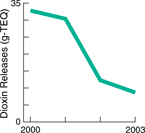 |
Summary Table: Prevention -
Environmental Toxins
|
|
Only one measure per topic is displayed in the summary table. A complete set of measures, where they exist, can be found in the report.
| Trend key: |
 |
solid green - headed in the right direction |
| |
 |
dotted red - headed in the wrong direction |
| |
 |
dashed black - stable
or non-significant change (NSC) |
| |
Pesticides
1999-2002 |
Dioxins
1999-2003 |
| Measure |
Possible carcinogens, pesticides chlordane and DDT and their metabolites, measured in human blood. |
Measurement of TCDD in human blood adjusting for lipids, and toxic release inventory of dioxin releases in the environment. (Example: dioxin release). |
| Trend |
Rising (concentrations of DDT and oxychlordane); falling (trans-nonachlor and heptachlor epoxide)
(No graph is available for this measure)

|
Falling for the last 30 years due to reductions in man-made sources.

|
| Desired direction |
Falling  |
Falling  |
| Most recent estimate |
In 2001-2002, blood and urine concentrations (nanograms per gram) were: 49.7 for oxychlordane, 78.2 for trans-nonachlor, 21.6 for heptachlor epoxide, and 2,320 for DDT (DDE). |
Dioxin releases – 8.59 g-TEQ |
| Healthy People 2010 target |
Reduce blood and urine concentrations of: oxychlordane to 31.4 ng/g, trans-nonachlor to 55.6 ng/g, heptachlor epoxide to 16.7 ng/g, and DDT (DDE) to 1,250 ng/g. |
Reduce exposure of the population to pesticides, heavy metals, and other toxic chemicals, as measured by blood and urine concentrations of the substances or their metabolites. |
| More information |
|
|